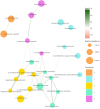Characterisation and comparison of semen microbiota and bacterial load in men with infertility, recurrent miscarriage, or proven fertility
- PMID: 40338640
- PMCID: PMC12061474
- DOI: 10.7554/eLife.96090
Characterisation and comparison of semen microbiota and bacterial load in men with infertility, recurrent miscarriage, or proven fertility
Abstract
Several studies have associated seminal microbiota abnormalities with male infertility but have yielded differing results owing to their limited sizes or depths of analyses. The semen microbiota during recurrent pregnancy loss (RPL) has not been investigated. Comprehensively assessing the seminal microbiota in men with reproductive disorders could elucidate its potential role in clinical management. We used semen analysis, terminal-deoxynucleotidyl-transferase-mediated-deoxyuridine-triphosphate-nick-end-labelling, Comet DNA fragmentation, luminol reactive oxidative species (ROS) chemiluminescence, and metataxonomic profiling of semen microbiota by 16S rRNA amplicon sequencing in this prospective, cross-sectional study to investigate composition and bacterial load of seminal bacterial genera and species, semen parameters, ROS, and sperm DNA fragmentation in men with reproductive disorders and proven fathers. 223 men were enrolled, including healthy men with proven paternity (n=63), the male partners in a couple encountering RPL (n=46), men with male factor infertility (n=58), and the male partners of couples with unexplained infertility (n=56). Rates of high sperm DNA fragmentation, elevated ROS, and oligospermia were more prevalent in the study group compared with control. In all groups, semen microbiota clustered into three major genera-dominant groups (1, Streptococcus; 2, Prevotella; 3, Lactobacillus and Gardnerella); no species clusters were identified. Group 2 had the highest microbial richness (p<0.001), alpha-diversity (p<0.001), and bacterial load (p<0.0001). Overall bacterial composition or load has not been found to associate with semen analysis, ROS, or DNA fragmentation. Whilst global perturbation of the seminal microbiota is not associated with male reproductive disorders, men with unidentified seminal Flavobacterium are more likely to have abnormal seminal analysis. Future studies may elucidate if Flavobacterium reduction has therapeutic potential.
Keywords: fertility; human; medicine; microbiota; semen.
© 2024, Mowla, Farahani et al.
Conflict of interest statement
SM, LF, TT, RD, GC, YL, SK, SK, ES, RR, LR, DK, RH, SM, WD, JB, PB, DM No competing interests declared, CJ Receives an investigator-led grant from LogixX Pharma Ltd
Figures







Update of
- doi: 10.1101/2024.02.18.580923
- doi: 10.7554/eLife.96090.1
- doi: 10.7554/eLife.96090.2
- doi: 10.7554/eLife.96090.3
Similar articles
-
Association between semen microbiome disorder and sperm DNA damage.Microbiol Spectr. 2024 Aug 6;12(8):e0075924. doi: 10.1128/spectrum.00759-24. Epub 2024 Jun 20. Microbiol Spectr. 2024. PMID: 38899893 Free PMC article.
-
Microbiota of the seminal fluid from healthy and infertile men.Fertil Steril. 2013 Nov;100(5):1261-9. doi: 10.1016/j.fertnstert.2013.07.1991. Epub 2013 Aug 29. Fertil Steril. 2013. PMID: 23993888 Free PMC article.
-
Bacterial communities in semen from men of infertile couples: metagenomic sequencing reveals relationships of seminal microbiota to semen quality.PLoS One. 2014 Oct 23;9(10):e110152. doi: 10.1371/journal.pone.0110152. eCollection 2014. PLoS One. 2014. PMID: 25340531 Free PMC article.
-
The semen microbiome and its impact on sperm function and male fertility: A systematic review and meta-analysis.Andrology. 2021 Jan;9(1):115-144. doi: 10.1111/andr.12886. Epub 2020 Oct 7. Andrology. 2021. PMID: 32794312
-
Association between sperm DNA fragmentation and idiopathic recurrent pregnancy loss: a systematic review and meta-analysis.Reprod Biomed Online. 2019 Jun;38(6):951-960. doi: 10.1016/j.rbmo.2018.12.029. Epub 2018 Dec 22. Reprod Biomed Online. 2019. PMID: 30979611
References
Publication types
MeSH terms
Substances
Grants and funding
LinkOut - more resources
Full Text Sources
Medical

